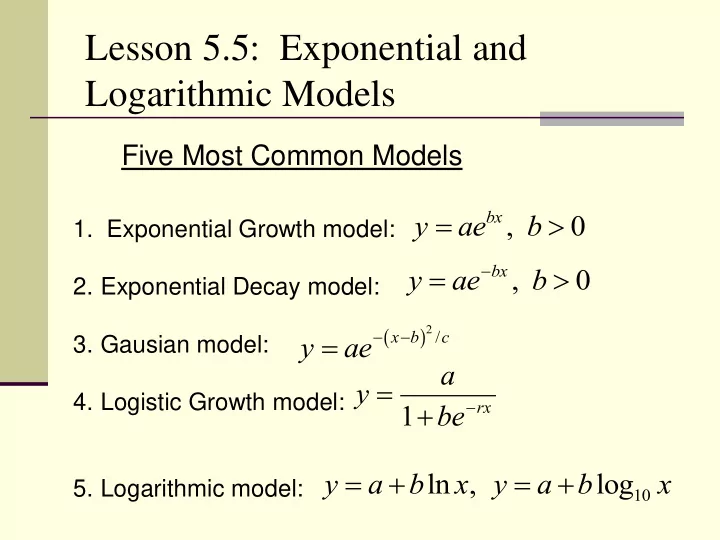

Lesson 5.5: Exponential and Logarithmic Models Five Most Common Models bx y ae , b 0 1. Exponential Growth model: , bx y ae b 0 2. Exponential Decay model: b g 2 / x b c y ae 3. Gausian model: a y 4. Logistic Growth model: be rx 1 y a b ln , x y a b log 10 x 5. Logarithmic model:
Ex 1: Exponential Growth In a research experiment, a population of fruit flies is increasing according to the law of exponential growth. After 2 days there are 100 flies, and after 4 days, there are 300 flies. How many flies are there after 5 days? ae bx y x = time, y = # of flies
ae bx y x = time, y = # of flies a 100 ae b 33 0 549 2 100 . x y e 100 3 a b g 33 0 549 5 . 33 e b 2 y e e b 2 ln ln 3 ae b 514 4 300 y flies F I 100 b ln 2 3 H K 4 b 300 e 2 b e b ln3 100 2 e b 300 2 e b 2 3 0549 .
Ex 2: Exponential Decay In living organic material, the ratio of the number of radioactive carbon isotopes (carbon-14) to the non- radioactive carbon isotopes (carbon-12) is about 1 to 10 12 . When organic material dies, its carbon-12 content remains fixed while the carbon-14 begins to decay with a half-life of 5700 years. To estimate the age of dead organic material, scientists us the following formula, which denotes the ratio of carbon-14 to carbon-12 present at 1 any time t (in years) e t / 8223 R 10 12 Find the age of a newly discovered fossil if the ratio of 1 carbon-14 to carbon-12 is 10 13
Ex 2: Continued. Half-life of Carbon-14 = 5715 years. How long until only 25% of fossil is remaining? b g 0 00012 . x . 25 C Ce k ln .5 ae kx y 0 00012 . x 5715 . 25 e 5715 k b g c h .5 C Ce 000012 . 0 00012 . x ln . 25 ln e e 5715 k .5 b g 000012 . x ln . 25 b g c h b g 5715 k ln . 5 ln e ln . 25 x b g 000012 . k ln . 5715 5 11552 x , years
Ex 3: Logarithmic Model On the Richter Scale, the magnitude, R, of an earthquake intensity, I, is I log 10 R I 0 where I 0 is the minimum intensity used for comparison. Find the intensities per unit of area for the following earthquakes. (Intensity is a measure of the wave energy of an earthquake.) A. Tokyo and Yokohama, Japan 1923: R = 8.3 B. El Salvador, 2001: R = 7.7
Ex 3: Continued. I I 7 7 . log 8 3 . log 199 526 2315 , , . 10 10 1 1 50118 7234 , , . 3981 . 83 . log I 7 7 . log I 10 10 Conclusion: The 7 7 . log I log I 8 3 . 10 10 10 10 10 1923 earthquake 10 had an intensity I 10 7 7 . I 10 8 3 approximately . four times I 50118 7234 I 199 526 2315 , , . greater than the , , . 2001 earthquake Homework: p.416-417 #37, 39, 42, 51, 52
Recommend
More recommend